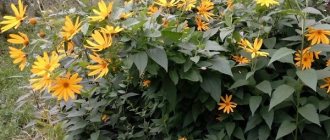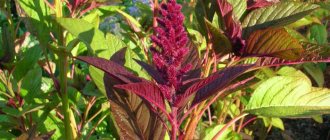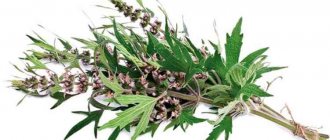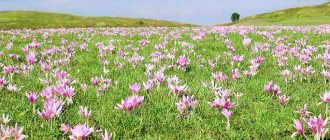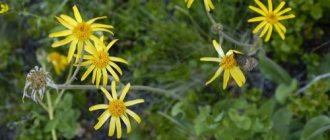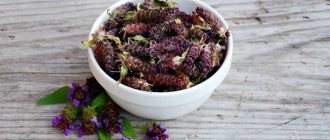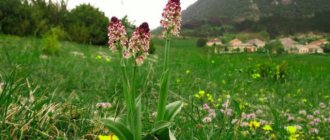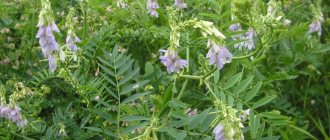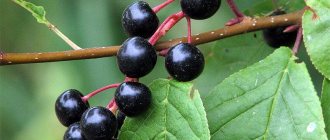Lily of the valley is not only a beautiful and pleasantly smelling flower, but also a medicinal plant with a unique property. It will help against many diseases, but if taken incorrectly it can be fatal.
When lilies of the valley bloom, it immediately becomes clear that spring has entered into full force . The aroma of this wonderful plant spreads far throughout the area, and the exquisite flowers are collected in fragrant bouquets.
But not only for their beauty . In many countries they are officially recognized as a medicinal plant . Lily of the valley has a huge number of beneficial properties . Let's try to figure out why this fragrant flower is so useful.
Lily of the valley: medicinal and healing properties
Since ancient times, the medicinal properties of this flower have been known to mankind. Tinctures from its flowers are used to treat heart disease and in ophthalmology . At the beginning of the last century, a pure medicine was obtained from lily of the valley, which acquired the name convaltoxin .
Lilies of the valley are not only beautiful, but also healing
Despite the fact that people have known about the usefulness of lily of the valley for a long time, this plant came into official medicine relatively recently. In the mid-19th century, Inozemtsev was published in one of the scientific journals . But no one paid her enough attention. And only a few decades later, the famous doctor Botkin introduced tinctures of lily of the valley into his practice to treat heart disease.
A few years later, pharmacists isolated a powder from lily of the valley that had a beneficial effect on the heart .
When the powder was produced, it was not sufficiently purified, so patients began to complain about side effects. After that, the lily of the valley was forgotten for some time. And even after the powder began to be effectively purified, people were wary of this drug . Only several decades later, Botkin again returned the lily of the valley its well-deserved recognition.
Lily of the valley is most often used to treat cardiovascular diseases.
This flower contains substances that have a beneficial effect on the heart muscle . It also contains various acids, such as citric and malic, starch and aspargine.
Lily of the valley contains substances that act on the heart, which stabilizes the heart rhythm, and they also affect blood vessels.
Lily of the valley is used in the treatment of heart diseases, neuroses and vices . It has the property of dilating blood vessels, so it is used for hypertension . With its help, blood circulation processes are improved, toxins and harmful fluids are removed from the body.
It is advisable to take lilies of the valley as a sedative
This wonderful plant is also used for nervous breakdowns, as a sedative . The arsenal of useful properties of lily of the valley includes a hypnotic effect. It is used to treat epilepsy, thyroid problems, headaches and paralysis.
By acting on the renal vessels, the substances contained in lily of the valley expand them, thereby increasing the outflow of fluid. It perfectly helps to cope with swelling during pregnancy and eliminates symptoms during menopause .
Treatment recipes
In the pharmacy chain you can purchase a variety of drugs that contain lily of the valley.
- Tincture
You can buy lily of the valley tincture (50 ml) for 300 rubles. Recommended for neurocircular dystonia. The list of indications also includes stage I of chronic heart failure. Take 15-20 drops 2-3 times a day.
Article for you:
Macadamia tincture: how to prepare and use for treatment
The use of the drug is prohibited for ventricular tachycardia, endocarditis, and cardiosclerosis. Do not use for angina pectoris, myocarditis, 1st or 2nd degree AV block.
- Lily of the valley-valerian drops
The average price of a 25 ml bottle is 20 rubles. Indications for use include stages I and II of chronic heart failure, insomnia, cardioneurosis, and increased nervous excitability.
Take 20 drops two to three times a day. The prohibition is myocarditis, the period of lactation and pregnancy, endocarditis.
- Kardompin
In addition to the May lily of the valley extract, the Kardompin preparation contains hawthorn, adonis, peppermint, and valerian.
Indications for use include cardiac pathologies - mild insufficiency, neuroses and disorders during menopause.
In the morning on an empty stomach before breakfast you need to take 12-15 drops. Repeat 20-25 drops in the evening before bed. The appointment is made only by the doctor.
- Korglykon
The solution for injection "Korglikon" contains a glycoside obtained from the foliage of the lily of the valley. The price of a package with 10 ampoules of 1 ml each is 72-95 rubles.
Indications for drug administration include acute left ventricular failure, atrial flutter, atrial fibrillation, and paroxysmal tachycardia.
The dosage for adults is 0.5-1 ml. The procedures are carried out twice a day. Do not use the drug during lactation, pregnancy, Wolff-Parkinson-White syndrome, intermittent complete blockade, glycoside intoxication.
Lily of the valley tincture - instructions for use
For several hundred years now, folk healing You can prepare a tincture from this plant yourself, it will not be difficult. It is recommended to take it for:
- gastrointestinal diseases
- urinary tract ailments
- cardiovascular diseases and tachycardia
- for washing eyes with severe conjunctivitis
- insomnia and nervous excitability
- febrile conditions, malaria and rheumatism
- epilepsy
- intestinal colic and asthma
There are many lily of the valley products in the assortment of pharmacies.
You can buy an alcohol tincture of lily of the valley . To use, it must be diluted with ten parts of water.
There are also tinctures of lily of the valley with the addition of other medicinal herbs, such as hawthorn or valerian. In combination, these drugs are used for thyroid diseases, atherosclerosis, nervous system disorders and insomnia .
A unique tincture of lily of the valley is considered a potent remedy . Therefore, before using it to treat any problems, you must always consult a doctor .
Lily of the valley: medicinal properties and contraindications, benefits and harms
Of course, eating one or two lily of the valley flowers will not bring much harm to an adult, although they will not add any health benefits. But they can cause poisoning in small children.
Medicines cannot be taken:
- pregnant and lactating women;
- children under 14 years of age;
- people with severe organic heart diseases: myocardial infarction, endocarditis, cardiosclerosis (drugs slow down the heartbeat, cause severe arrhythmia);
- people with liver and kidney diseases.
The intense aroma of flowers, which many women like so much, can also be harmful to health. The smell can cause a sharp headache and loss of consciousness. Under no circumstances should you go to bed in a room where there are picked flowers. There are known cases of death among people who fell asleep in a room with closed windows and a large number of bouquets. People who mistakenly drank water containing cut flowers also suffered.
The medications prescribed by the doctor must be taken in small doses, monitor the condition of the body, and strictly adhere to the dosage and dosage schedule.
It is not recommended to take lily of the valley decoctions for liver pathologies, endocarditis, cardiosclerosis, or chronic diseases at the acute stage. It is also better for children and pregnant women to avoid using home remedies. When used correctly, decoctions or infusions based on lily of the valley may cause virtually no side effects.
Compound
Lily of the valley: use in folk medicine
Traditional medicine has long been familiar with the healing properties of lily of the valley . It contains a huge amount of useful substances. The flowers and leaves of the plant are mainly used . The raw materials are dried in a shady place and then taken if necessary.
Flowers, leaves and stems of lily of the valley are used to prepare medicinal tinctures, powders, and oils.
Tachycardia
A tablespoon of dry substance is poured into a glass of boiling water. Then this solution is infused for a couple of hours. The infusion must be filtered and taken fifteen milliliters every two hours .
You can use brewed lily of the valley as a sedative and decongestant. In this case, it is taken four times a day, a tablespoon. The course of such treatment should not exceed two weeks .
Lily of the valley can be brewed as tea and drunk as a sedative instead of valerian or motherwort.
Glaucoma
Lily of the valley can slow down the disease and lower intraocular pressure . In this case, lily of the valley is mixed with nettle. A tablespoon of dried lily of the valley flowers and half a glass of nettle are poured with thirty milliliters of boiling water and allowed to brew for eight hours. It should turn out to be a porridge-like mass. It is applied to a bandage and applied to the eyelids for half an hour . The course of treatment is two weeks.
Lily of the valley in combination with other plants is used for eye diseases
Conjunctivitis
To prevent this disease you will need an alcohol tincture of lily of the valley:
- chop the flowers and leaves of the plant
- pour ten parts of alcohol solution
- keep the infusion for a couple of weeks in a dark place and strain
- Dilute a teaspoon of medicine in a glass of water and wash your eyeballs with this mixture twice a day .
Heart diseases
To treat heart problems, an infusion of lily of the valley, dill, mint and valerian is used. Take a tablespoon of each drug, brew it in a liter of boiling water and leave to infuse for an hour. Strain and consume orally, 150 milliliters per day for two weeks .
Lily of the valley is used to treat cardiovascular diseases
Climax
To eliminate symptoms during menopause, take an infusion of lily of the valley with honey . To do this, brew a tablespoon of dry lily of the valley in a glass of boiling water. Then filter and add a spoonful of honey. You need to drink twenty milliliters five times a day .
But remember, before using traditional recipes, be sure to consult your doctor .
Treatment
You need to select the most effective treatment methods using folk recipes based on lily of the valley together with your doctor. This will allow you to more accurately calculate dosages, taking into account the characteristics of the body, and prevent harm to health.
Hearts
For cardiovascular diseases, fresh silverberry flowers are used in combination with dried hawthorn inflorescences, motherwort grass and wild carrot seeds in a ratio of 2:2:1:1.
The thoroughly mixed mixture in a glass vessel is combined in a ratio of 1:5 with vodka. After two weeks of infusion in the dark, the healing agent is filtered using a two-layer bandage. You need to take 20-25 drops, diluted in 50 ml of water, three to four times a day.
- For arrhythmia
Alternative medicine successfully uses lily of the valley tincture, made independently with vodka, for arrhythmia.
Take 10-15 drops of the remedy three times a day. Such therapy also has a beneficial effect on nervous disorders, insomnia, and heart pain.
Eye
In order to carry out preventive measures aimed at preventing and treating conjunctivitis, a remedy from May lily of the valley infused with alcohol is used.
Before the procedure, 1 tsp. The product is dissolved in 200 ml of chilled boiled water. Wash your eyes with this liquid. Sessions are practiced in the morning and evening.
Joints
Lily of the valley tincture effectively relieves pain, inflammation, and swelling in joint lesions. Use homemade variations with vodka or alcohol.
Soak a soft cotton cloth folded in four layers with the healing agent. Apply to the affected joint. Additionally, it is insulated with a woolen scarf. Leave the lotion for 1.5 hours. During the day, it is advisable to carry out such manipulations in the morning and evening.
Article for you:
Rosehip tincture: what helps and how to take it correctly
A good effect can also be obtained by rubbing aching joints with tincture of lily of the valley, practicing these actions every eight hours.
Hypertension
In order to reduce pressure, 30 crushed dried lily of the valley flowers are placed in a glass vessel. Add 200 ml of vodka.
The mixture must be infused under a cork in a dark cabinet for 8 days. After filtration, you should take 15-30 drops of the healing elixir every day, first diluted with a tablespoon of water. The course is continued until blood pressure levels normalize.
Epilepsy
Lily of the valley buds are carefully washed and dried for 40 minutes, scattered on a terry towel. Then the raw materials are ground in an earthenware bowl with a wooden pestle and transferred to a bottle with natural table wine. Maintain a ratio of 1:10.
Additionally, based on 500 ml of tincture, add honey - 3 tbsp. l. and crushed lemon balm leaves - 2 tbsp. l. The sealed product is left to infuse without light for 14 days. Take 1 tsp per day. should be infused 2-3 times.
Lily of the valley: heart treatment
In folk medicine, lily of the valley is deservedly considered a heart healer . This is an effective medicine for many diseases of the cardiovascular system . An alcohol tincture is used for treatment. We wrote above about how to prepare it. The main medicinal substance of lily of the valley is capable of:
- restore heart rhythm
- improve the clinical picture of heart disease
- stabilize blood circulation
Lily of the valley - a healer of the heart
What does lily of the valley help with?
Before you begin to consider diseases that can be combated with the help of May lily of the valley, you should familiarize yourself with the medicinal effects of the plant. It is prescribed as a cardiotonic, sedative, choleretic, diuretic, antispasmodic and vasodilator drug. Therefore, lily of the valley helps against many ailments.
Being an excellent cardiotonic, the plant is used for various heart defects, as well as cardiosclerosis, myocardial dystrophy and paroxysmal tachycardia. Lily of the valley normalizes the functioning of the heart muscle and has a strengthening effect, and as such is indicated in both folk and traditional therapy.
If cardiac edema occurs, treatment with lily of the valley is also prescribed. Possessing a diuretic effect, it quickly restores fluid balance in the body, preventing its retention, which leads to edema.
For those suffering from neuroses and insomnia, lily of the valley is indicated as a strong sedative that is not addictive and can be used for a long time.
In case of hypertension, the vasodilating property of the plant helps. By quickly and effectively relieving vascular spasm, which is the cause of increased pressure, lily of the valley returns pressure to normal levels. The flower will not be able to completely cure hypertension, but it can significantly improve the patient’s condition.
Headaches, paralysis and epilepsy often respond to the positive effects of drugs based on lily of the valley. However, before starting treatment, in this case it is necessary to consult with your doctor, who will determine whether the prescribed chemicals will be combined with lily of the valley and whether an undesirable chemical reaction will occur.
Traditional healers also treat diseases of the thyroid gland using lily of the valley. It is believed that the plant helps normalize the functioning of this part of the body and promotes the proper absorption of iodine, which is very important for the health of the thyroid gland.
At elevated temperatures caused by a cold or flu, the plant will help not only reduce it, but also speed up recovery. In parallel with this, lily of the valley will also relieve inflammation of the throat, which usually accompanies these diseases.
For rheumatism, the use of preparations from the plant is indicated as a means of relieving pain and preventing heart damage. For this disease, the plant should be used in complex therapy.
How dangerous is lily of the valley: poisonous properties
Along with its beneficial properties, lily of the valley also has negative properties. He is very poisonous ! Even the water where the flowers of this plant stood contains a large amount of toxic substances.
Lily of the valley should never be used for self-medication , as this can lead to very unpredictable consequences.
In addition to its benefits, lily of the valley can also cause serious harm
Berries are especially . They can cause severe poisoning, heart failure and hallucinations. Therefore, if you use lily of the valley for medicinal purposes, be extremely careful !
Lily of the valley poisoning symptoms
Lily of the valley is a poisonous plant, you should remember this and never exceed the dosage . In case of overdose, the following unpleasant symptoms may occur:
- first nausea and then severe vomiting
- weakness of the whole body
- abnormal heart rhythm that can lead to complete cardiac arrest
- drowsiness
- flickering begins before the eyes, hallucinations may appear
Doctors do not recommend placing bouquets of lilies of the valley in the bedroom and especially in the nursery
If you do not provide timely assistance for such poisoning , a person can expect death .
In case of poisoning, the first thing the victim needs to do is call an ambulance. During the waiting period, you can do some manipulations :
- Dilute manganese and give it to the patient to drink. This will induce vomiting and empty the stomach
- Give the victim any sorbent drugs
- You can do an enema to cleanse the intestines
Effect of drugs on the body, recipes
The above-ground part of the plant - flowers and leaves - contains more than 10 cardiac glycosides, an alkaloid, essential oil, and organic acids.
Preparations from lily of the valley normalize the rhythm and strength of heart contractions, relieve pain in the heart area, shortness of breath, act as a diuretic, relieving cyanosis and swelling, act as a sedative hypnotic
Having a selective effect on the heart, glycosides are characterized by low stability and do not accumulate in the body with prolonged use, therefore they do not have a toxic effect and are prescribed even to children and pregnant women.
Tincture of fresh flowers
Fill the container 3/4 full with fresh flowers, then fill to the top with 90% alcohol. Infuse in a dark, cool place for 2 - 3 weeks. Take 20 drops 5 times a day with water. Children – from 1 to 12 drops.
Infusion of dried flowers
Brew one tablespoon of dried flowers with a glass of boiling water, leave for half an hour under the lid. Take by the table. spoon every 2 hours.
This infusion is used to wash the eyes for conjunctivitis.
Medicine for extrasystole
The mixture has the following composition:
- valerian – 10 ml
- May lily of the valley tincture – 10 ml
- hawthorn extract – 5 ml
- menthol – 0.05 ml
Take 20-30 drops 3 times a day. Extrasystole is a violation of the heart rhythm, extraordinary contractions of the heart.
May lily of the valley is a well-known and often used medicinal plant.
There are pharmacological preparations in pharmacies - tincture and drops of Zelenin, used as a sedative for cardiac and other forms of neuroses; cardiotonic drugs – tincture and “Korglikon” – solution for injection; the drug “Convaflavin” in tablets is used for cholecystitis, cholangitis as a choleretic agent.
Warning
Lily of the valley is a poisonous plant! The plant contains convallatoxin. Children should not pick flowers and berries; they should wash their hands after touching the plants.
Why is lily of the valley dangerous? Its preparations contain potent substances, an overdose of which can cause poisoning. In case of poisoning, nausea, tinnitus, palpitations, slow pulse, and general weakness appear.
During treatment, you must follow the doctor’s recommendations and strictly adhere to the permissible dosage of the drug.
Contraindications to the use of lily of the valley
As already mentioned, lily of the valley is very poisonous . Therefore, the use of drugs should be carried out only in consultation with a doctor. Be sure to follow the indicated doses !
Medicines made from lily of the valley have many contraindications, which should be checked with your doctor.
It is not recommended to use preparations made on the basis of an aromatic plant for people who suffer from kidney and liver problems, as well as severe endocarditis.
Also, lily of the valley should not be used for myocardium, changes in blood vessels and pronounced problems in the cardiovascular sphere. You should not inhale the scent of lily of the valley for a long time, as this can also lead to a deterioration in your health.
Contraindications
May lily of the valley is a potent medicinal plant, contraindicated in the following cases:
- Acute kidney and liver diseases;
- Diseases of the gastrointestinal tract;
- Myocarditis in the acute phase;
- Sudden organic changes in the heart or blood vessels;
- Endocarditis;
- Severe cardiosclerosis.
Lily of the valley is a poisonous plant because contains a strong glycoside, convallatoxin, so it should be used with extreme caution, only after consulting a doctor, strictly in accordance with his recommendations and under his supervision. Children suffer especially severe toxic effects from this plant; there are known cases of severe poisoning caused by ingestion of lily of the valley berries. If a child develops nausea and vomiting, the stomach should be rinsed immediately and a cleansing enema should be given.
If the recommended dose is exceeded, nausea, vomiting, abdominal pain, dilated pupils, tinnitus, dizziness, drowsiness, bradycardia, severe weakness, ventricular flutter, extrasystole and even cardiac arrest are possible.
How to prepare lily of the valley tincture at home: recipe
Let's take a look at a couple of recipes for tinctures that are not difficult to prepare yourself.
Water
- Dried lily of the valley flowers and leaves in the amount of one teaspoon
- A glass of boiling water
Lily of the valley tincture can be easily prepared at home.
Pour boiling water over the ingredient, cover the container and let it brew for about an hour. Next, strain the liquid and take a tablespoon no more than 4 times a day .
Alcohol
- Fresh lily of the valley flowers
- Pure medical alcohol
Pour the flowers of the plant into a half-liter jar so that they occupy a third of the volume. Fill it to the top with alcohol, close the lid tightly and put it in a dark place for two weeks . In this case, the contents of the jar must be shaken periodically.
Then you need to drain the liquid through cheesecloth. You can take no more than 90 drops per day. Dilute with boiled water.
Do not forget that before taking lily of the valley preparations, you must consult with your doctor.
Recipes for making tinctures
May lily of the valley is successfully used in folk treatment. Based on this medicinal plant, you can make healing tinctures at home in strict accordance with proven recipes.
On vodka
You will need dried lily of the valley flowers. They are poured into a half-liter jar up to 3/4 of the volume. Vodka is poured up to the neck.
Keep the container under the lid in cool conditions without access to light for 15 days. Squeeze the prepared elixir through a double gauze napkin.
On alcohol
Dried lily of the valley inflorescences and foliage are combined in bottles with alcohol (70%) in a ratio of 1:10. The hermetically sealed vessel is placed in a cool, shaded place for two weeks. Then the liquid fraction is filtered through a gauze filter.
Article for you:
Dill tincture: what helps and how to take it correctly
Storage, expiration date
The lily of the valley tincture made at home in a darkened glass vessel with a tight stopper is stored at an ambient temperature of no higher than 25 degrees. Provide protection from light. The shelf life of the healing elixir is two years.
What is lily of the valley harvested as a raw material?
To make various preparations, only the ground part of lilies of the valley , and these are leaves and flowers. Collection must be carried out in sunny weather; under no circumstances should this be done after rain. Lilies of the valley must be cut with a sharp knife or pruning shears. Do not pull them out along with the bulbs , because this will destroy the culture!
Picking a lily of the valley with a bulb will destroy the plant; moreover, the underground part is not used for medicinal purposes
The medicinal plant must be dried immediately after cutting . After it withers, the medicinal properties will sharply decrease.
It is better to carry out the drying procedure in a special apparatus . But if there is none, then place the raw materials in the shade and turn them over periodically. Once the plants are completely dry, they should be placed in a sealed container and stored in a cool, dark place.
Interesting Facts
The aroma of lilies of the valley is used in the perfume industry. It is difficult to obtain from flowers, and mainly in perfumery they use synthetic compounds that convey the aroma well and are easier to prepare.
Flowers have been grown as garden ornamental plants since the 16th century; they have wider leaves and larger flowers, and denser inflorescences. There are varieties with pink and double flowers, as well as variegated leaves. Forcing is widely practiced - growing in a shorter time for holidays.
These are the favorite spring flowers of many peoples. In France, the holiday was held on the first Sunday of May; now Lily of the Valley Day is celebrated on May 1 along with Labor Day. On this day, they decorate homes and holiday tables, and congratulate each other with postcards with their images.
The May lily of the valley was the favorite flower of Pyotr Ilyich Tchaikovsky. Tchaikovsky once wrote to his brother Modest from Florence: “The mere sight of these lovely flowers that are adorning my table at this moment is enough to instill a love for life.” The composer dedicated his poem to him: “O lily of the valley, why do you please the eyes so much?...”
This is such a beautiful, useful spring plant; lily of the valley has long been used in folk medicine for its medicinal properties.
I suggest you watch a short video.
What medicinal value do lily of the valley leaves and flowers have?
The leaves and flowers of the aromatic plant contain a large number of active substances , essential oils and acids , which have an excellent medicinal effect on the human body. In the history of medicines, lily of the valley occupies an important place.
Lily of the valley leaves and flowers are used to prepare tinctures.
In ancient times, in the Kingdom of Prussia, a tincture was invented to cure paralysis . Lily of the valley flowers were collected early in the morning; they were supposed to be covered with dew. And then they were insisted on wine.
In Foggy Albion, the tincture from this plant was called “golden water”. It was used as a panacea for nervous disorders , used to treat headaches, and was even saved from epidemics. And such an infusion was sold only in expensive bottles made of gold or silver.
The medicinal properties of lily of the valley are still used today and not only in folk medicine. The aromatic healer helps with a wide variety of diseases if used wisely and under the supervision of a doctor.
Description of the plant
Lily of the valley is a genus of plants that was previously included in the Liliaceae family or in a separate Lily of the Valley family.
Currently, as of 2013, this genus is part of the Asparagus family (Wikipedia). One main species is known - May lily of the valley (Convallaria majalis L.) with several varieties. It grows in the European part of Russia, as well as in the Caucasus, Eastern Siberia and the Far East in forests, forest edges, clearings, among bushes, in forest ravines, distributed in Western Europe and North America.
Lily of the valley description of the plant. A perennial herbaceous plant 15–30 cm high with a thin horizontal branched creeping rhizome, from which arise many almost vertical rhizomes 1–2 cm long, forming leaves and flowers in spring. Between two bright green oblong-elliptical leaves 10–20 cm long and 4–8 cm wide, there are from 6 to 20 white fragrant flowers on a bending triangular flower arrow. The flowers are located on arched pedicels - with a spherical-bell-shaped perianth with six stamens and a pistil.
The flowers do not contain nectar; they attract insects with a strong aroma and pollen. The plant is pollinated by bees and bumblebees and blooms in spring in May and June. After flowering, the leaves gradually die off, leaves appear again from perennial rhizomes the next year, and flower stalks are formed once every 2–3 years.
The fruit is a spherical orange-red berry with 2–8 seeds, ripening in August–September. The brightly colored berries attract birds, which eat and distribute them.
For medicinal purposes, the grass, leaves, flowers - the entire above-ground part of the plant - are harvested. They are collected in May - June during the flowering period and quickly dried in air in the shade with good ventilation or at a temperature of 50 - 60 ° C so that they do not darken. Fresh flowers are also used to prepare medicines.
The Russian generic name “lily of the valley” - from the word “smooth, smooth” - is associated with the large smooth leaves of the plant. The scientific name of the genus Convallaria majaris in Latin means “lily of the valleys, blooming in May.” In England it is called “Lily of the Valley”.
